Game Log 4 - CREATE
CREATE Methods
During the CREATE phase, we made use of two structured methods: Playable Prototypes and EXPO Plaque, both of which were instrumental in shaping and presenting Let’s Ceramic.
We developed a playable AR prototype that guides players through shaping, decorating, and firing, the three key steps of ceramic-making, using intuitive hand-tracking. Each stage is designed to reflect traditional techniques and foster deeper understanding of ceramic craft. The shaping and firing stages allow players to experiment with form and structure, while the decoration phase incorporates curated historical artworks that promote visual storytelling and cultural resonance. By blending embodied interaction with culturally informed content, the prototype offers more than gameplay, it encourages reflection, discovery, and appreciation.
In preparation for the final exhibition, we also designed a visually engaging poster that explains the core concept of the game, highlights key cultural references, and guides visitors through the player experience. The plaque was intended to help audiences quickly grasp both the interactive and educational goals of Let’s Ceramic, especially during in-person showcases.
Process Documentation
1. Researching Ceramic Heritage
We began by studying traditional ceramic craftsmanship in depth, identifying the key stages and their cultural significance. This informed our decision to structure the game around three core stages: shaping, decorating, and firing.
2. Collecting and Stylizing Artwork
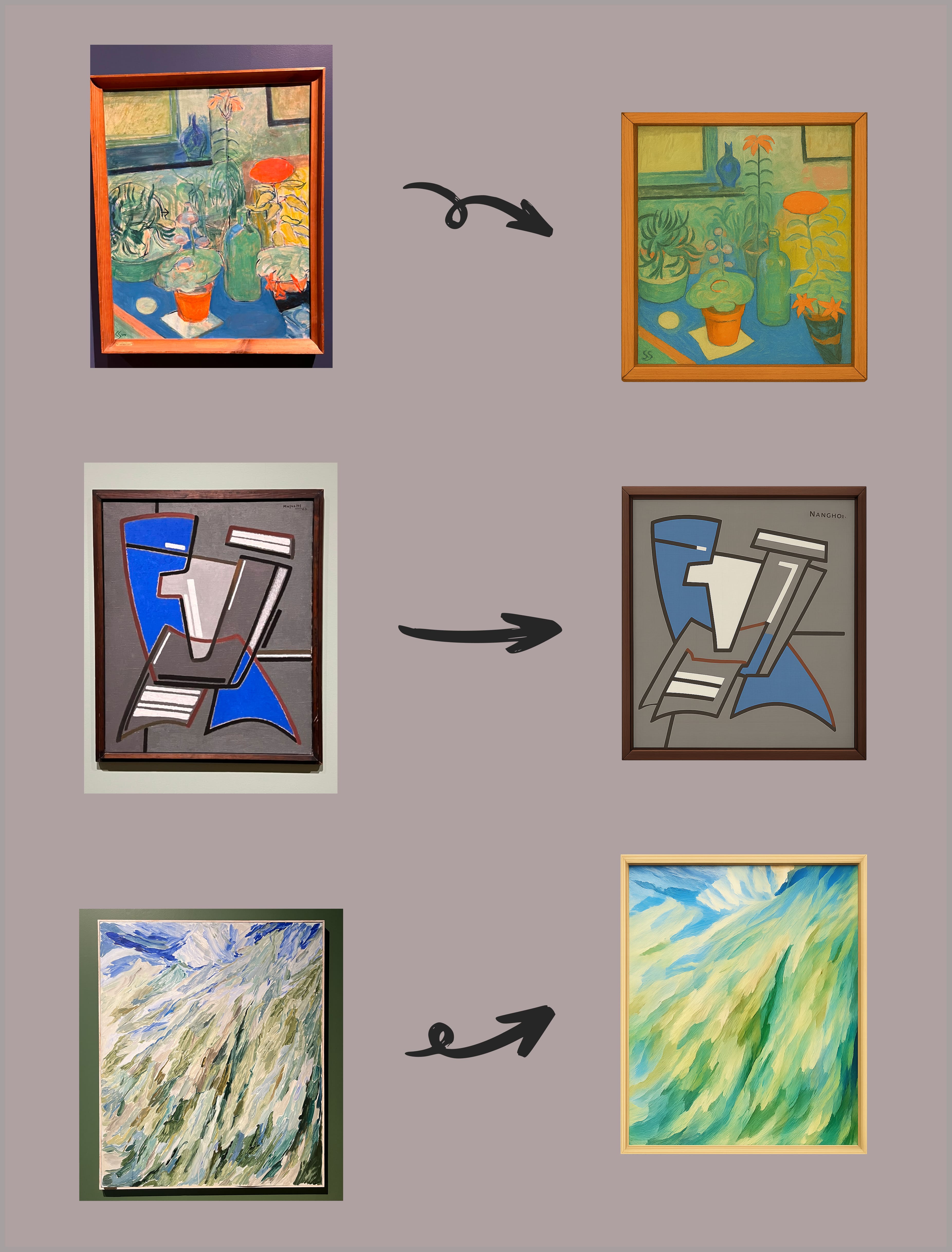
We photographed real-world artworks and used generative AI tools to transform them into a unified visual style while preserving the original appearance and cultural meaning. These adapted artworks were then used in the decoration stage of the game.
3. Prototyping
We focused on designing and developing a game that aligns with our core goal: communicating ceramic heritage through interactive play. All three stages,shaping, decorating, and firing,were developed using Unity and Meta XR Interaction SDK on the Quest 3S headset. Throughout prototyping, we continually refined each phase to enhance cultural clarity, engagement, and playability.
4. Playtesting
We tested the prototype with Group 1. Feedback was used to refine gesture recognition, improve visual feedback (especially during firing), and confirm the cultural clarity of each game phase.
EXPO Preparation
1. Concept
Our game is an AR game that transforms traditional ceramic craftsmanship into an interactive digital journey. By guiding players through the processes of shaping, decorating, and firing, the game invites users to actively participate in cultural learning through embodied play. Drawing on real ceramic practices and curated artworks, the experience emphasizes both tangible techniques and intangible heritage in a playful, immersive format.
2. Game Prototype
Following the real-world process of creating ceramics, our game is divided into three phases. Each phase is designed to echo a specific cultural practice: gesture-based shaping simulates hand-throwing techniques, decoration involves selecting from traditional artworks, and firing introduces the unpredictability of kiln-based finishing. Together, these elements form a cohesive experience that communicates both the tactile and symbolic aspects of ceramic heritage. 🏺🎨🔥
Shaping Phase
In the shaping phase, players interact with a virtual lump of clay using intuitive hand gestures. The ceramic is divided into horizontal segments, each representing a section of the vessel. The left hand controls segment selection by palm height, while a pinch gesture confirms the selection. The right hand's rotation then adjusts the shape of the selected segment, enlarging or narrowing it. This approach mimics the logic of wheel throwing while providing a structured method for digital deformation, encouraging players to explore both form and control.
Decoration Phase
The decoration phase invites players to explore a virtual wall of stylized historical artworks. Players can select an artwork using a pinch gesture. Once selected, the artwork is applied as a surface texture to the ceramic, automatically adapting to the current shape of the vessel. These artworks were processed through generative AI to unify visual style while retaining cultural identity. The process emphasizes visual storytelling, enabling users to build a personal connection between traditional imagery and their self-created object.
Firing Phase
In the firing stage, players must pick up firewood from the ground and place it into a kiln to initiate the ceramic's transformation. Hand gestures are used for grasping and dropping wood using Meta XR Interaction SDK. Once the firewood is placed, the kiln ignites and begins to heat up. Visual cues, such as a gradual color change in the ceramic surface, and ambient fire sound effects are included to signal the firing process.
3. Exhibition Materials
We designed a visual poster titled Let’s Ceramic! to accompany our EXPO presentation.
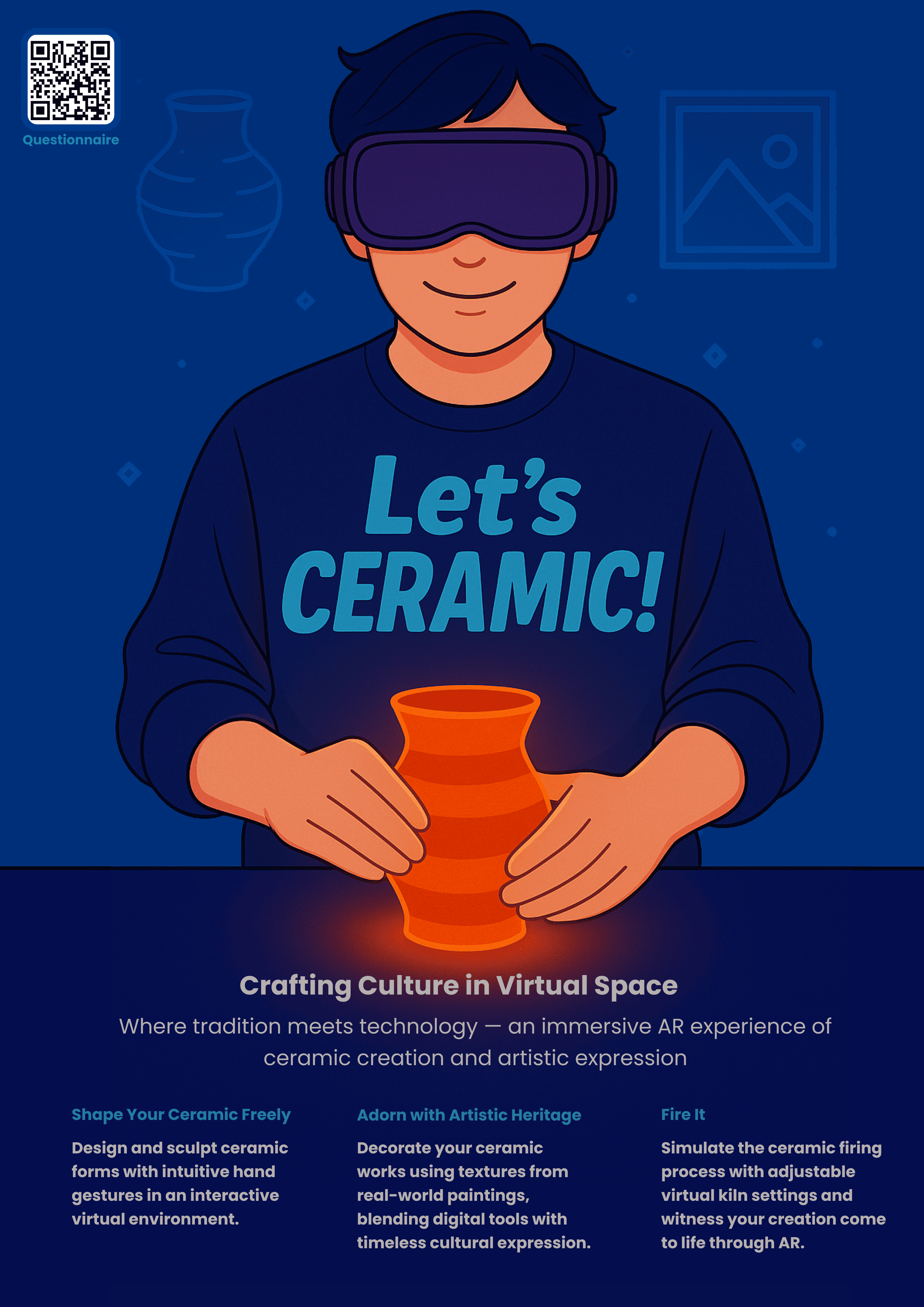
The EXPO poster for Let’s Ceramic visually encapsulates the core theme of the game, bringing traditional ceramic-making into a modern, interactive AR experience. At the center of the design is a character wearing a VR/AR headset, smiling with focused attention as they shape a glowing ceramic vessel. This figure represents the player, engaging hands-on with cultural heritage through immersive technology. The joyful expression communicates accessibility and creative freedom.
The t-shirt prominently displays the phrase “Let’s Ceramic!”, serving as both the project’s title and a direct invitation to engage. Below, the slogan “Crafting Culture in Virtual Space” is paired with a short explanation, positioning the game as a space where tradition and technology meet. The bottom section outlines the game’s three interactive stages:shaping, decorating, and firing, each introduced with a concise phrase and a sentence describing its purpose. These clearly reflect the structure of the game and guide the viewer’s understanding of the experience.
A QR code placed in the upper-left corner links directly to our feedback questionnaire, reinforcing the poster’s dual role as both introduction and evaluation tool. Overall, the visual style, layout, and messaging work together to express the project’s emphasis on cultural preservation, intuitive interaction, and playful learning.
Questionnaire Evaluation
To evaluate Let’s Ceramic, we conducted a structured questionnaire with 8 participants, covering 17 items across five thematic sections. Each item used a 5-point Likert scale (1 = Strongly Disagree, 5 = Strongly Agree). The following summarizes the results based on both average scores (M) and response variability (SD), highlighting key strengths and areas for refinement.
1. Cultural Heritage Awareness and Appreciation
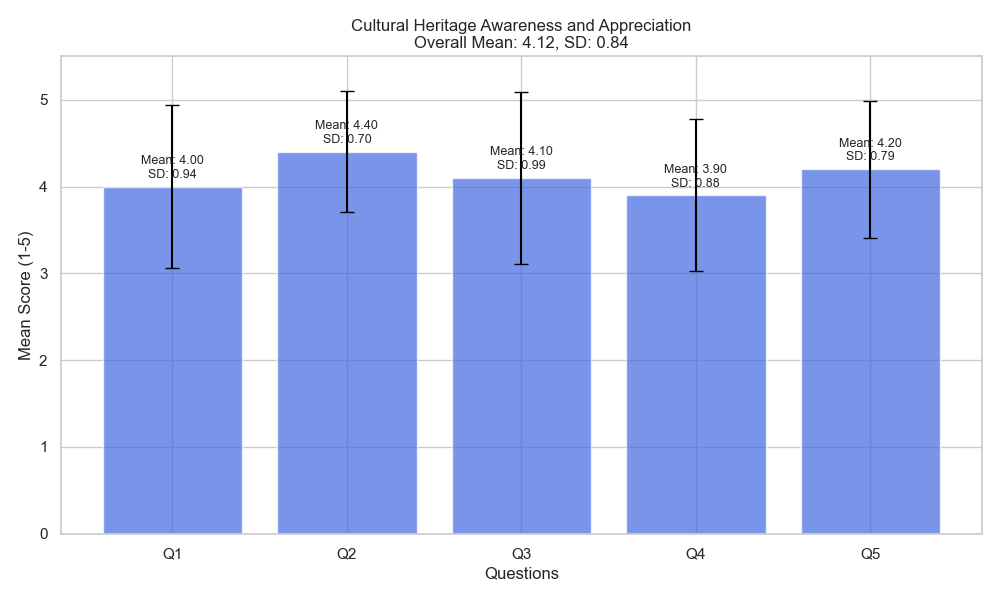 This dimension yielded an overall mean score of 4.12 (SD = 0.84), indicating that participants generally perceived the game as effective in conveying cultural heritage values. Among the items, Q2 (“I could clearly sense the connection between the game and ceramic heritage”) received the highest rating (M = 4.40, SD = 0.70), demonstrating strong participant consensus regarding the thematic alignment between gameplay and ceramic tradition. Similarly, Q5 (“This game helps promote and experience the value of cultural heritage through art and craft”) was rated highly (M = 4.20, SD = 0.79), underscoring the perceived educational and cultural value of the game experience. In contrast, Q1 and Q3 received slightly lower scores (M = 4.00 and 4.10, respectively), though still within a favorable range. Notably, Q4 (“The combination of ceramic heritage and artworks enhanced my cultural appreciation”) recorded the lowest mean (M = 3.90), suggesting that the integration of visual art and ceramic heritage may not have been fully appreciated by all participants. These findings suggest that while the cultural dimension was generally well communicated, the symbolic connection between traditional art forms may require further clarification or visual emphasis in future iterations.
This dimension yielded an overall mean score of 4.12 (SD = 0.84), indicating that participants generally perceived the game as effective in conveying cultural heritage values. Among the items, Q2 (“I could clearly sense the connection between the game and ceramic heritage”) received the highest rating (M = 4.40, SD = 0.70), demonstrating strong participant consensus regarding the thematic alignment between gameplay and ceramic tradition. Similarly, Q5 (“This game helps promote and experience the value of cultural heritage through art and craft”) was rated highly (M = 4.20, SD = 0.79), underscoring the perceived educational and cultural value of the game experience. In contrast, Q1 and Q3 received slightly lower scores (M = 4.00 and 4.10, respectively), though still within a favorable range. Notably, Q4 (“The combination of ceramic heritage and artworks enhanced my cultural appreciation”) recorded the lowest mean (M = 3.90), suggesting that the integration of visual art and ceramic heritage may not have been fully appreciated by all participants. These findings suggest that while the cultural dimension was generally well communicated, the symbolic connection between traditional art forms may require further clarification or visual emphasis in future iterations.
2. Gameplay and Mechanics
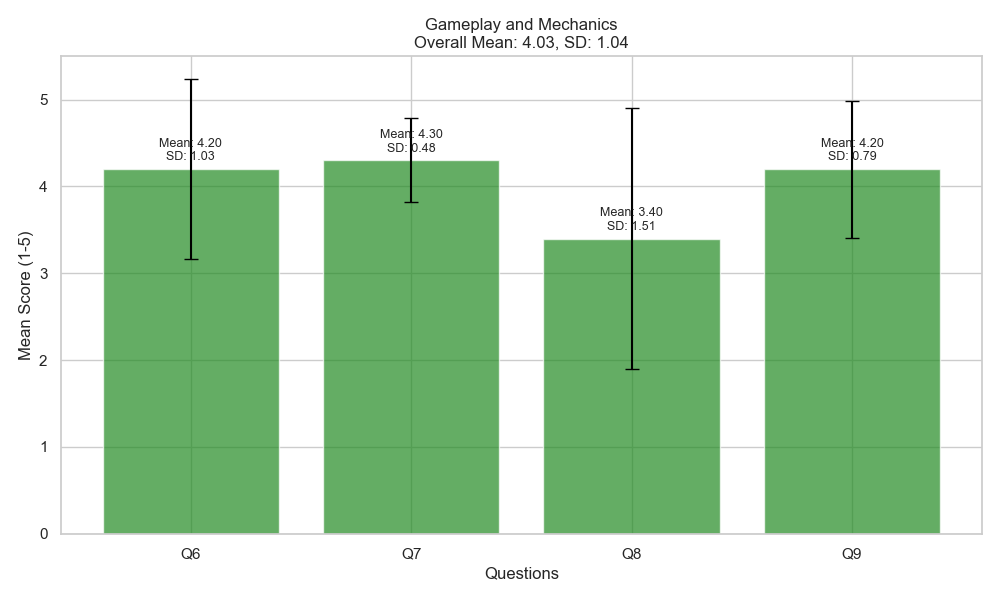 The overall mean for this section was 4.03 (SD = 1.04), indicating a generally positive evaluation of the game mechanics, albeit with more variance across participants. Q7 (“I enjoyed the freedom to customize ceramic shapes and decorations”) received the highest score (M = 4.30, SD = 0.48), reflecting both high satisfaction and consistency in user experience. Q6 ("Shaping ceramics with AR felt immersive and engaging.") and Q9 ("Even though the prototype is not complete, I can imagine how the full gameplay would feel.") both got average scores of 4.20, indicating favorable responses, though their relatively larger standard deviations suggest some heterogeneity in user interaction fluency or prototype performance. The most notable deviation was observed in Q8 (“Controlling the firing temperature gave me a sense of real-time involvement”), which received the lowest mean (M = 3.40) and the highest dispersion (SD = 1.51). This suggests considerable variation in user experience, potentially due to interface usability issues or a lack of clarity in how firing mechanisms were implemented. Overall, while core interactive elements such as shaping and customization appear to be strengths, refinement is needed in procedural mechanics (e.g., firing control) to ensure a uniformly engaging experience.
The overall mean for this section was 4.03 (SD = 1.04), indicating a generally positive evaluation of the game mechanics, albeit with more variance across participants. Q7 (“I enjoyed the freedom to customize ceramic shapes and decorations”) received the highest score (M = 4.30, SD = 0.48), reflecting both high satisfaction and consistency in user experience. Q6 ("Shaping ceramics with AR felt immersive and engaging.") and Q9 ("Even though the prototype is not complete, I can imagine how the full gameplay would feel.") both got average scores of 4.20, indicating favorable responses, though their relatively larger standard deviations suggest some heterogeneity in user interaction fluency or prototype performance. The most notable deviation was observed in Q8 (“Controlling the firing temperature gave me a sense of real-time involvement”), which received the lowest mean (M = 3.40) and the highest dispersion (SD = 1.51). This suggests considerable variation in user experience, potentially due to interface usability issues or a lack of clarity in how firing mechanisms were implemented. Overall, while core interactive elements such as shaping and customization appear to be strengths, refinement is needed in procedural mechanics (e.g., firing control) to ensure a uniformly engaging experience.
3. AR Interaction and Immersion
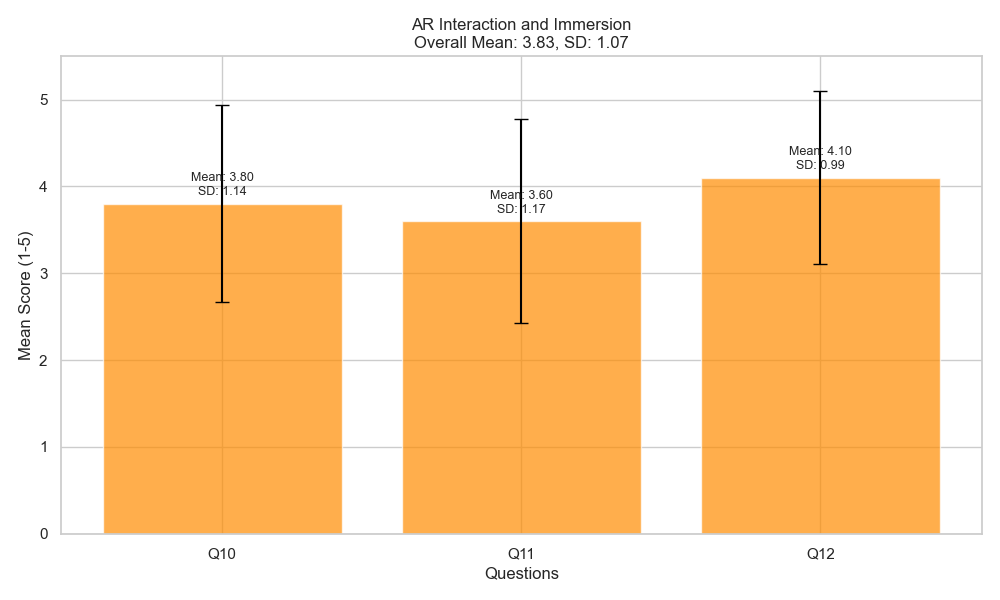 This section recorded a lower overall mean of 3.83 (SD = 1.07), reflecting a more mixed perception of AR-related features. Q12 (“The interactions [e.g., placing ceramics, adding wood] were intuitive and enjoyable”) achieved the highest rating in this domain (M = 4.10, SD = 0.99), suggesting that foundational interactions were accessible and well-integrated. However, Q10 (“AR enhanced the immersive experience...”) and Q11 (“Manipulating and placing ceramics in physical space felt natural and realistic.”) received lower ratings (M = 3.80 and 3.60, respectively), coupled with relatively high standard deviations (>1.1), indicating inconsistent experiences with spatial interaction. These results imply that while the AR component contributed to immersion for some users, others may have encountered usability challenges—such as tracking imprecision or unclear feedback—which disrupted immersion. To enhance overall effectiveness, future design iterations may benefit from optimizing AR responsiveness, improving hand-object alignment, and reinforcing the cultural significance of spatial interaction.
This section recorded a lower overall mean of 3.83 (SD = 1.07), reflecting a more mixed perception of AR-related features. Q12 (“The interactions [e.g., placing ceramics, adding wood] were intuitive and enjoyable”) achieved the highest rating in this domain (M = 4.10, SD = 0.99), suggesting that foundational interactions were accessible and well-integrated. However, Q10 (“AR enhanced the immersive experience...”) and Q11 (“Manipulating and placing ceramics in physical space felt natural and realistic.”) received lower ratings (M = 3.80 and 3.60, respectively), coupled with relatively high standard deviations (>1.1), indicating inconsistent experiences with spatial interaction. These results imply that while the AR component contributed to immersion for some users, others may have encountered usability challenges—such as tracking imprecision or unclear feedback—which disrupted immersion. To enhance overall effectiveness, future design iterations may benefit from optimizing AR responsiveness, improving hand-object alignment, and reinforcing the cultural significance of spatial interaction.
4. Overall Impression and Future Intentions
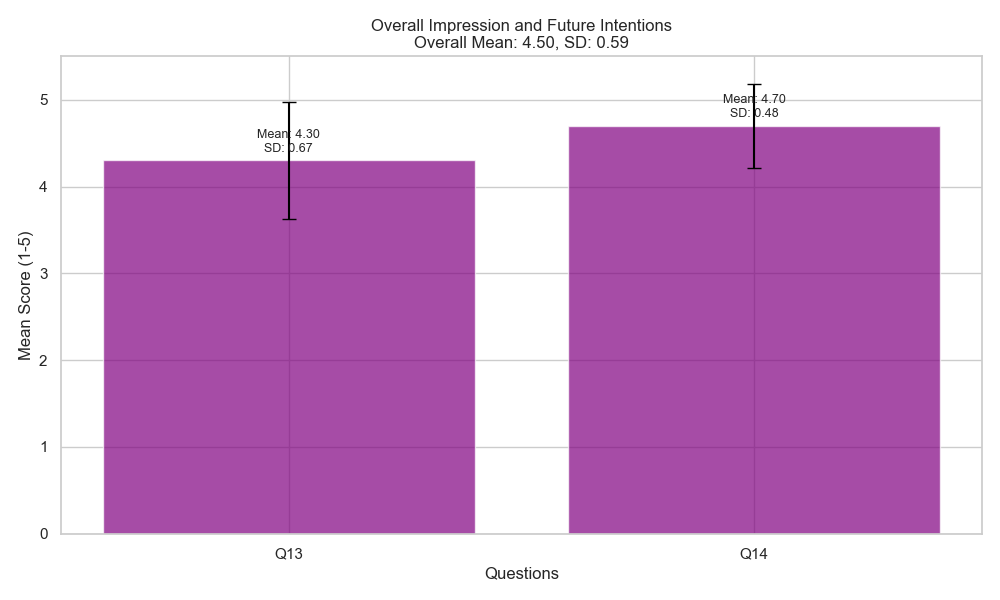 This section yielded the highest average score among all dimensions, with a mean of 4.50 and a low standard deviation of 0.59, reflecting high and consistent levels of user satisfaction. Q14 (“I would like to try a more complete version of this game...”) achieved the highest individual score across the entire questionnaire (M = 4.70, SD = 0.48), indicating strong enthusiasm for future engagement. Q13 (“The overall game experience was satisfying and meaningful”) also received a favorable evaluation (M = 4.30, SD = 0.67), reinforcing the notion that the game, even in prototype form, successfully communicated its intended value. The limited variance in this section further suggests a robust and coherent positive experience, with participants demonstrating a clear willingness to re-engage with the game in more complete or culturally enriched forms. These findings highlight a promising foundation for iterative development and broader cultural impact.
This section yielded the highest average score among all dimensions, with a mean of 4.50 and a low standard deviation of 0.59, reflecting high and consistent levels of user satisfaction. Q14 (“I would like to try a more complete version of this game...”) achieved the highest individual score across the entire questionnaire (M = 4.70, SD = 0.48), indicating strong enthusiasm for future engagement. Q13 (“The overall game experience was satisfying and meaningful”) also received a favorable evaluation (M = 4.30, SD = 0.67), reinforcing the notion that the game, even in prototype form, successfully communicated its intended value. The limited variance in this section further suggests a robust and coherent positive experience, with participants demonstrating a clear willingness to re-engage with the game in more complete or culturally enriched forms. These findings highlight a promising foundation for iterative development and broader cultural impact.
5. Open-Ended Responses
Player comments reinforced the quantitative results. Phrases like “Everything is fun” and “Yes, freedom” reflect high enjoyment and a strong sense of agency in shaping and design. “Set fire” and “create ceramic depend on painting” indicate that players remembered specific interactions and understood the connection between art and material outcomes. The comment “more easy to adjust shape” offered a constructive suggestion, pointing to the need for improved precision or feedback in hand-based deformation. These comments affirm that the core design—especially shaping and decoration—resonated well, but they also suggest practical next steps in refining interaction clarity and cultural communication.
Reflection and Future Work
Designing Let’s Ceramic made us think deeply about how cultural heritage can be shared through doing, not just telling. From the beginning, our goal was to let players feel the process of shaping, decorating, and firing ceramics through their hands. Using gestures helped turn traditional skills into interactive actions. Based on user feedback, this goal was largely successful—many players said shaping and customizing their own ceramic pieces were the most meaningful parts of the experience.
One of our main challenges was finding a balance between realism and ease of use. We wanted shaping and firing to feel authentic, but still easy for beginners. This led to simplifications like segmented shaping and stylized decoration. However, questionnaire results showed that some users found the gesture control during shaping and the squeezing interactions in the modeling stage unclear or hard to use. These are key areas we plan to improve in the next version.
From a technical perspective, we used Unity and Meta XR tools to support full hand-tracking on Quest 3S. Basic interactions worked well, but shaping gestures still lacked precision and needed better calibration. In addition, although we designed a temperature-based firing system to let users control firing heat in real time, a system bug prevented it from working properly in this version. As a result, the feature was not fully presented to players during EXPO. Fixing and completing this part will be a major focus moving forward, as it adds both realism and interactive depth.
Next, we plan to improve Let’s Ceramic in two main ways. First, we want to add more curated artworks and background stories to strengthen the cultural dimension. Second, we aim to improve gesture tracking, visual feedback, and the shaping and firing systems to make the experience smoother and more engaging. We also hope to adjust difficulty and tutorials to better support both new and experienced players.
In the end, this project showed us that digital interaction can be a powerful tool for preserving and sharing culture—if it is built with care, user input, and respect for traditional crafts. Let’s Ceramic is only the beginning, and we’re excited to keep improving it.
Get Let's Ceramic!
Let's Ceramic!
| Status | Released |
| Authors | Yunhui Song, HaiyangXu |
More posts
- Game Log 3 - IMAGINEMay 13, 2025
- Game Log 2 – PLAYApr 15, 2025
- Game Log 1 – ExperienceMar 26, 2025
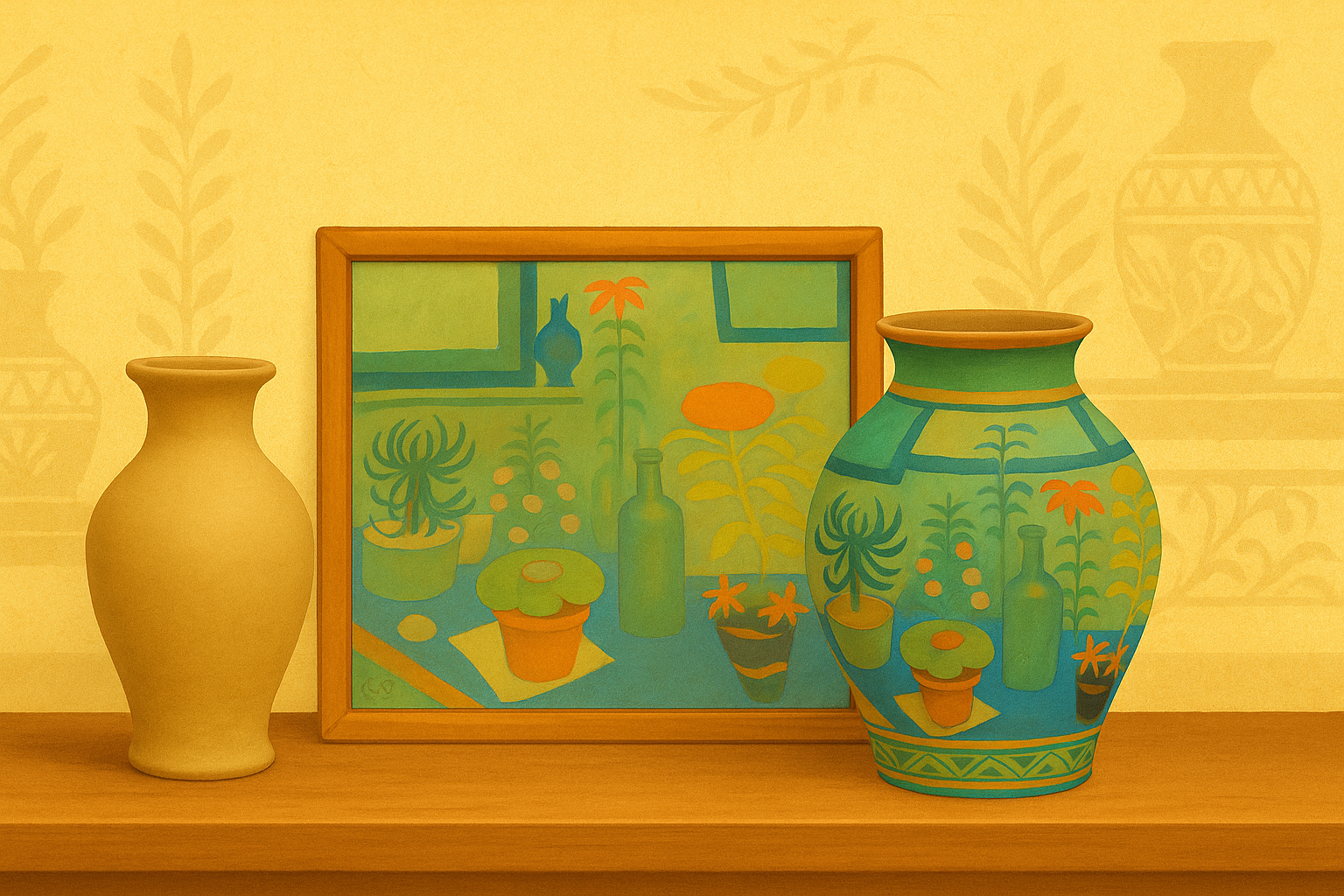
Leave a comment
Log in with itch.io to leave a comment.